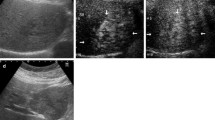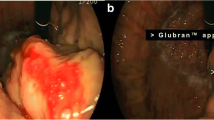Abstract
Diffuse cavernous hemangioma of the rectum (DCHR) is a relatively rare disease. A 40-year-old man presented with long-standing lower abdominal discomfort and hematuria. At the time of hospitalization, his vital signs and hemoglobin level were normal. Colonoscopy showed markedly dilated blood vessels in the sigmoid mucosa, which was confirmed on magnetic resonance imaging and computed tomography as cavernous hemangioma. Without surgery, there have been no signs of progression of DCHR during a 3-year follow-up period.
Similar content being viewed by others
Avoid common mistakes on your manuscript.
Introduction
Diffuse cavernous hemangioma of the rectum (DCHR) is a rare benign vascular tumor that is characterized by delayed diagnosis.
We report a case of a 40-year-old man who was admitted to our hospital due to long-standing lower abdominal discomfort and hematuria. He had no history of fever, abdominal pain, intermittent rectal bleeding, or weight loss. He also had no notable medical history or family history. His vital signs were normal and laboratory testing revealed a normal complete blood count without anemia.
Colonoscopy showed markedly dilated blood vessels in the sigmoid mucosa (Fig. 1). Abdominal computed tomography (CT) revealed mucosal wall thickening from the sigmoid colon to the rectum, with hyperplasia of fatty tissue around the rectum. Venodilation with associated thrombosis in the dilated veins and multiple calcified foci associated with phleboliths were also detected (Fig. 2). Magnetic resonance imaging (MRI) also showed thickened wall from the sigmoid colon to the rectum, with tortuous and dilated vessels in the fatty tissue (Fig. 3). These findings were consistent with DCHR, and we decided to observe the patient. During a 3-year follow-up, there were no signs of progression of DCHR.
Discussion
DCHR is a rare clinical condition, which mainly affects young adults. Since the first case of rectal hemangioma reported by Phillips in 1839, there have been only approximately 350 cases reported worldwide [1]. Recurrent painless rectal bleeding is the usual clinical symptom of DCHR and more than half of these patients have some degree of anemia [2]. However, DCHR may sometimes present as lower abdominal discomfort without the usual symptoms and may be misdiagnosed as hemorrhoids, colitis, polyposis, or rectal varicosities due to portal hypertension [1].
Although this disease presents with nonspecific symptoms, colonoscopy and abdominal CT and MRI can reveal specific findings that can serve as diagnostic clues; these typical and characteristic findings are irregularly thickened rectal wall and multiple calcified foci of pelvic phleboliths. In DCHR, biopsy is contraindicated because of the high risk for bleeding; the findings on CT or MRI are usually sufficient to make the diagnosis [2]. Multiple bluish submucosal varicosities and slight oozing are typical colonoscopic findings in DCHR [3, 4]. The presence of all these findings in this case confirmed the diagnosis.
Generally, complete surgical resection of DCHR is the only treatment and most cases are operated to control rectal bleeding [2]. Alternative therapies, such as sclerotherapy and selective embolization, cannot control rectal bleeding because DCHR originates from the dentate line and involves all layers of the rectal wall and the rectal mesentery. In previous reports, 33 of 43 DCHR cases underwent surgery (Table 1) [1, 5–9]. However, surgical resection of DCHR is complicated and can cause massive intraoperative bleeding; in a few cases, intermittent postoperative rectal bleeding was reported [1, 5]. In this case, there were no severe manifestations, such as bleeding or anemia, so we opted for observation without surgery. Fortunately, there have been no signs of progression of DCHR during a 3-year follow-up period and we were able to preserve the colon without invasive treatment.
In conclusion, colonoscopy, abdominal CT and MRI are useful to make a diagnosis of DCHR, and some case, especially those without a history of bleeding, could be followed-up efficiently without excessive invasive examinations.
References
Wang HT, Gao XH, Fu CG et al (2010) Diagnosis and treatment of diffuse cavernous hemangioma of the rectum: report of 17 cases. World J Surg 34:2477–2486
Yorozuya K, Watanabe M, Hasegawa H et al (2003) Diffuse cavernous hemangioma of the rectum: report of a case. Surg Today 33(4):309–311
Aylward CA, Orangio GR, Lucas GW et al (1998) Diffuse cavernous hemangioma of the rectosigmoid—CT scan, a new diagnostic modality, and surgical management using sphincter-saving procedures: report of three cases. Dis Colon Rectum 31:797–802
Lupetin AR (1990) Diffuse cavernous hemangioma of the rectum: evaluation and MRI. Gastrointest Radiol 15:343–345
Nawa T, Yoshihara H, Yamada Y et al (2008) A case of diffuse cavernous hemangioma of rectum in which fat-suppression MRI was useful for differential diagnosis. Gastroenterol Endosc 50:1304–1310
Leal RF, Ayrizono Mde L, Silva PV et al (2011) Laparoscopic-assisted bowel resection with construction of a colonic reservoir for cavernous hemangioma of the rectum: report of two cases. Tech Coloproctol 15(2):205–207
Kandpal H, Sharma R, Srivastava DN et al (2007) Diffuse cavernous haemangioma of colon: magnetic resonance imaging features. Report of two cases. Australas Radiol 51:B147–B151
Tan TC, Wang JY, Cheung YC et al (1998) Diffuse cavernous hemangioma of the rectum complicated by invasion of pelvic structures. Report of two cases. Dis Colon Rectum 41(8):1062–1066
Hasegawa H, Teramoto T, Watanabe M et al (1996) Diffuse cavernous hemangioma of the rectum: MR imaging with endorectal surface coil and sphincter-saving surgery. J Gastroenterol 31(6):875–879
Author information
Authors and Affiliations
Corresponding author
Ethics declarations
Conflict of interest
All authors declare that they have no conflicts of interest.
Informed consent
Written informed consent was obtained from the patient.
This case report was conducted in accordance with the Ethical Guidelines for Medical and Health Research Involving Human Subjects.
Rights and permissions
This article is published under an open access license. Please check the 'Copyright Information' section either on this page or in the PDF for details of this license and what re-use is permitted. If your intended use exceeds what is permitted by the license or if you are unable to locate the licence and re-use information, please contact the Rights and Permissions team.
About this article
Cite this article
Osaki, K., Mori, Y., Ozaki, Y. et al. Successful conservative management of diffuse cavernous hemangioma of the rectum. Int Canc Conf J 6, 8–10 (2017). https://doi.org/10.1007/s13691-016-0262-x
Received:
Accepted:
Published:
Issue Date:
DOI: https://doi.org/10.1007/s13691-016-0262-x







